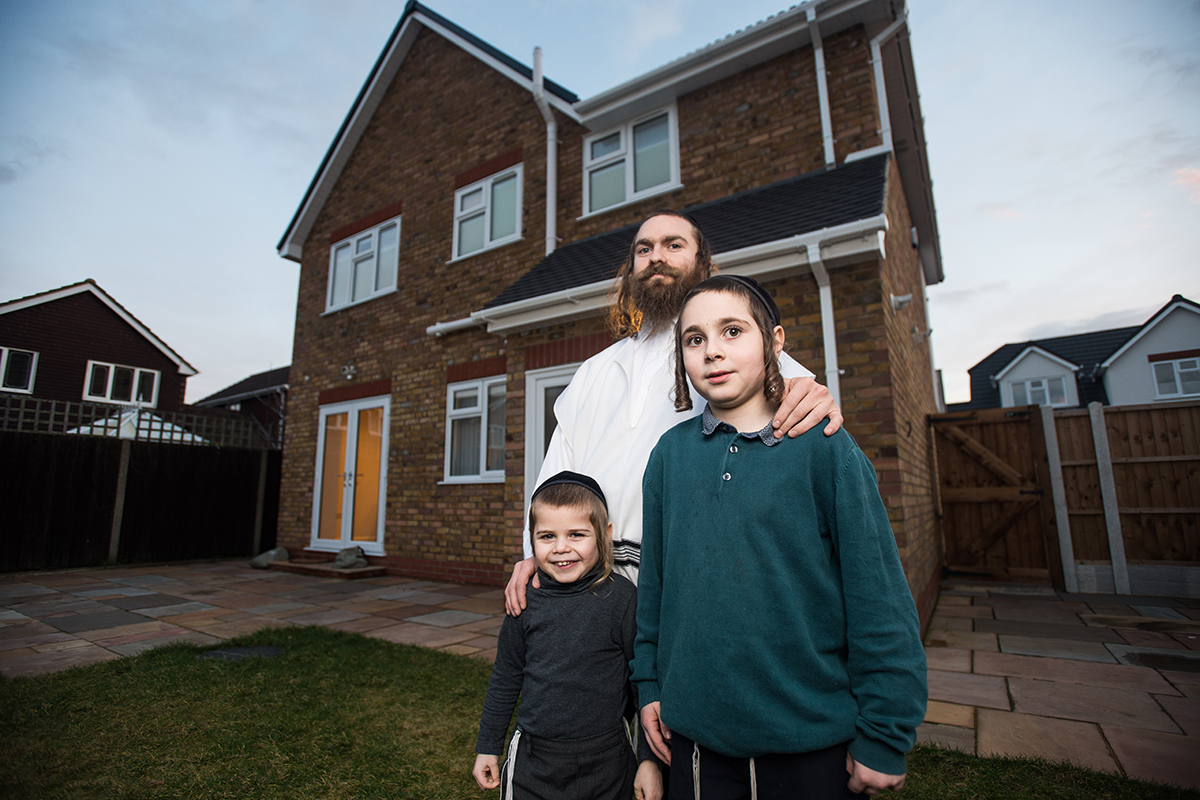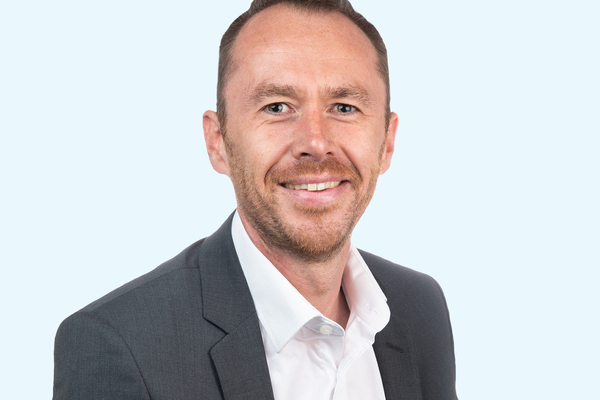The community that moved to Canvey Island
Two social landlords are helping ultra-Orthodox Jewish people move from London to Essex for a better quality of life. Martin Hilditch finds out more.. Photography by Simon Brandon
Naftali Noe with two of his children
Back in 1885, the living conditions endured by poor Jewish families in London’s East End were so gruesome that the Jewish Board of Guardians’ sanitary commission found many homes were “utterly unfit for human habitation”.
Action was taken as a result, including the founding of a small housing company, the Four Per Cent Industrial Dwellings Company (named after the return it promised investors), to provide poorer Jewish families with decent homes.
That company, now a 1,400-home housing association called IDS (Industrial Dwellings Society), has been providing decent housing for the Jewish community in London for 133 years.
But the severe housing stress faced by some of the communities it serves has returned with a vengeance. Skyrocketing rents and a lack of affordable alternatives have resulted in many families squeezing into overcrowded homes in a poor condition in the private rented sector.
The pressure is so great that IDS, along with many members of the Jewish community it serves, is being forced to look outside of London for a solution.
This is the story of how a remote corner of Essex – Canvey Island, separated from the mainland by a network of creeks – has become the destination for an organised relocation of scores of families from one of London’s best-known communities of ultra-Orthodox Jews, in Stamford Hill, Hackney.
It is also about how IDS, along with another housing association, Agudas Israel, has moved outside of its traditional area of operation to help out, and how and why it is gearing up for a big expansion.
A new development of four homes in a quiet suburban street in Canvey Island, just around the corner from local nature reserve Canvey Lake, has already made a huge difference to four families.
In fact, if you were looking for a study of how housing can transform people’s lives, this would be a good place to start.
The recently completed homes are owned by IDS and the families moved there in October 2017. Naftali and Miriam Noe moved into one four-bedroom home with their four young children. They moved from a two-bedroom privately rented home in Stamford Hill, which was in a pretty dire state.
The community’s story was featured in a BBC documentary in January. Watch a trailer here:
“Never mind the space, the house was in a terrible condition,” Mr Noe states. “It was mouldy. There were broken windows. The hot water was on and off, and on and off. When the children were home all they could do was run around the dining room or the kitchen. It was not healthy for them, let alone for their parents.”
Today the children have a sizeable back garden to enjoy as well as a more spacious property in a better condition.
The family are incredibly enthusiastic about the impact the move has had on their lives.
“It is a paradise here,” Ms Noe states. She says that the cramped life the family previously experienced in Stamford Hill “wasn’t really living”.
Alan Finkel, director of housing at IDS, says that families “will make the best of it – but when you see what people are making the best of, it is shocking”.
Ms Noe admits to some nerves about the move initially. “It was leaving behind everything I was familiar with,” she says. But within days of the move she realised the decision had been the correct one.
“The children just blossomed,” she says. “Because they were so happy and so cheerful I could slowly but surely get my bearings.”
Joel and Reizel Krausz are the Noes’ neighbours, and have three young children of their own.
They moved from a two-bedroom privately rented flat in Stamford Hill at the same time as the Noe family.
“Once we looked at the house we didn’t have a decision left to make,” Ms Krausz states, enthusing about the “beautifully built” four-bedroom house and the garden that her children can play in safely. In Stamford Hill they had access to a small communal area.
She says that when the family go back to visit their in-laws one of her daughters “gets scared that we are going back to the two-bedroom flat”.
While IDS’s purchase of the new homes made both of these families’ moves possible, it was given the confidence to invest because of a wider relocation to Canvey Island by other Haredi – or ultra-Orthodox – Jews from Stamford Hill.
They have been attracted by the comparatively affordable house prices, relative proximity to their family and friends in London, and the friendly welcome from the existing community.
Ms Krausz says she and her husband were the 30th family to relocate here from Stamford Hill, and others have since followed.
“Are you going to buy a house in Stamford Hill? Are your children? Forget about it.” – Joel Friedman
Joel Friedman and his family were among the first to make the move, along with six others, 18 months ago, moving from a rented two-bedroom home to a five-bed house that he owns.
He says he never had any doubts that more members of the community would follow. “Even people who are pessimistic [about moving to Canvey] in Stamford Hill don’t have a solution. [The question is] are you going to buy a house in Stamford Hill? Are your children? Forget about it. So what is going to happen?”
Other practicalities eased the relocation of more families. A Jewish philanthropist bought the site of a former secondary school for £1.75m last year – “the price of a nice house in Stamford Hill”, Mr Freidman states (five-bed homes can certainly fetch well over £1m).
The existing buildings on the extensive site are now slowly being converted – the sound of drilling fills the air throughout our visit – into a range of community spaces, including a community centre, synagogue, and classroom activities for boys and girls.
Kosher food – easier to obtain in Stamford Hill than Canvey Island – is transported into a small shop on the site.
The site of the former secondary school purchased by a Jewish philanthropist
This is no random drift of people, though. The move, and future relocations, are being planned.
Mr Friedman says members of the community are talking about buying a chunk of the Thorney Bay caravan park, on the other side of the island, that is being sold off for housing. Because the Haredim are not allowed to use transport from sunset on Friday until Saturday night, the Jewish Sabbath, they have to live close to their places of worship.
One concern from the Jewish community had been that if they all settle close to the existing site it may lead to cohesion problems with the local community or drive up house prices in a concentrated area.
If homes could be obtained on the Thorney Bay site, this would reduce the danger of either of these problems occurring (although everyone we speak to on the day is effusive about the welcome they have had).
“If you get your 200 families over five years, or whatever it is, it is not good to have it all in one place,” Mr Friedman says. “If the long-term picture is that house prices start creeping up and it becomes a non-viable solution then we have shot ourselves in the foot. I mean, we are trying to make this work.”
As for IDS, it was given the confidence to invest in new homes by the move of the communities and because Agudas Israel was also buying a handful of homes in the area, creating some initial scale.
Suzanne Wolfe, chief executive of IDS since March last year, admits that Canvey Island is not the association’s “natural territory”.
“Our foothold is in north London, so it is a leap of faith for us as well [as those relocating],” she says.
Joseph Stauber, who was on the board of IDS up until last year and was involved in the early decision-making process, says he thinks there is a clear reason for it to expand its geographic reach.
A dedication sign for people who donate to the school to commemorate loved ones
“The motto of IDS is supporting communities,” he states. “And the Orthodox Jewish community has big problems overcoming a lack of space. The motto is our aim – so here we are.”
He says there are roughly 30 Jewish families in Stamford Hill who “are eager to go the minute IDS has places” in Canvey Island. “Thirty people would come up tomorrow,” he states.
“We have been able to achieve an awful lot more for four large families than we would have if we had been purchasing in London off the shelf,” Ms Wolfe adds. “The quality of life from what we are seeing [with the moves so far] is significantly superior.”
Does this mean that IDS is likely to consider buying more properties in Canvey Island?
At the moment the official line is that it is early days and it wants to look at how successful its initial investment proves to be.
Nonetheless, the organisation has ambitious plans for the future.
Back in 1884, IDS was created following a report commissioned by the United Synagogue that recommended new Jewish settlers should be provided with decent, healthy homes. Today, IDS has embarked on new research with the Institute for Jewish Policy Research (JPR) to inform its future direction of travel.
Initial research with the JPR has highlighted specific issues with some ageing communities, large families and key workers, Ms Wolfe says. Additional outreach work and in-depth research is now being carried out that will inform IDS’s response.
A milk delivery for the on-site schools
Whatever the result, it is set for a rapid expansion. After growing to 1,400 homes in its first 133 years, it is set to increase in size by more than a third in the next decade with a net addition of 500 homes.
“We have carried out a review of our assets and we are currently exploring where the investment is targeted,” Ms Wolfe says. “The ongoing research is part and parcel of how we want to make those investment decisions.
“Certainly we recognise that we have got very, very substantial potential to invest in partnership or singly. There are a lot of options to evaluate.”
Ms Wolfe says her guiding principle is that “the housing association movement is here to provide homes” and she wants to return to IDS’s early principles of “direct action”.
There is interest in further investment in Canvey Island, she states, before adding “we are also interested in some of the opportunities inside London”, and there are “one or two interesting partnerships with charities that are under discussion”.
For now though, the research is revealing “there is really hidden Jewish housing need” and the next step is drawing up that action plan.
Either way, the relocation of members of Jewish communities from Stamford Hill is set to continue.
“I must say, when I saw the families in their homes I thought to myself ‘that’s a very good piece of housing work and investment’,” Ms Wolfe adds. “You come away from here feeling absolutely uplifted.”
















